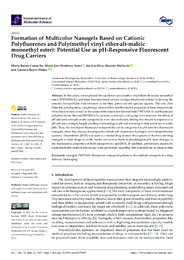Título :
Formation of Multicolor Nanogels Based on Cationic Polyfluorenes and Poly(methyl vinyl ether-alt-maleic
monoethyl ester): Potential Use as pH-Responsive Fluorescent Drug Carriers |
Autor :
Rubio-Camacho, Marta 
Martínez Tomé, María José
MIRA CARRIÓ, AMALIA 
Mallavia, Ricardo 
Reyes Mateo, Carmen |
Editor :
MDPI |
Departamento:
Departamentos de la UMH::Agroquímica y Medio Ambiente |
Fecha de publicación:
2021-09-04 |
URI :
https://hdl.handle.net/11000/30576 |
Resumen :
In this study, we employed the copolymer poly(methyl vinyl ether-alt-maleic monoethyl
ester) (PMVEMA-Es) and three fluorene-based cationic conjugated polyelectrolytes to develop flu orescent nanoparticles with emission in the blue, green and red spectral regions. The size, Zeta
Potential, polydispersity, morphology, time-stability and fluorescent properties of these nanoparticles
were characterized, as well as the nature of the interaction between both PMVEMA-Es and fluorescent
polyelectrolytes. Because PMVEMA-Es contains a carboxylic acid group in its structure, the effects of
pH and ionic strength on the nanoparticles were also evaluated, finding that the size is responsive to
pH and ionic strength, largely swelling at physiological pH and returning to their initial size at acidic
pHs. Thus, the developed fluorescent nanoparticles can be categorized as pH-sensitive fluorescent
nanogels, since they possess the properties of both pH-responsive hydrogels and nanoparticulate
systems. Doxorubicin (DOX) was used as a model drug to show the capacity of the blue-emitting
nanogels to hold drugs in acidic media and release them at physiological pH, from changes in
the fluorescence properties of both nanoparticles and DOX. In addition, preliminary studies by
super-resolution confocal microscopy were performed, regarding their potential use as image probes.
|
Palabras clave/Materias:
nanogels
PMVEMA
fluorescent conjugated polymers
doxorubicin
nanoparticles
drug-delivery
bioimagi |
Área de conocimiento :
CDU: Ciencias puras y naturales |
Tipo de documento :
info:eu-repo/semantics/article |
Derechos de acceso:
info:eu-repo/semantics/openAccess |
DOI :
https://doi.org/10.3390/ijms22179607 |
Aparece en las colecciones:
Artículos Agroquímica y Medio Ambiente
|

 La licencia se describe como: Atribución-NonComercial-NoDerivada 4.0 Internacional.
La licencia se describe como: Atribución-NonComercial-NoDerivada 4.0 Internacional.
.png)